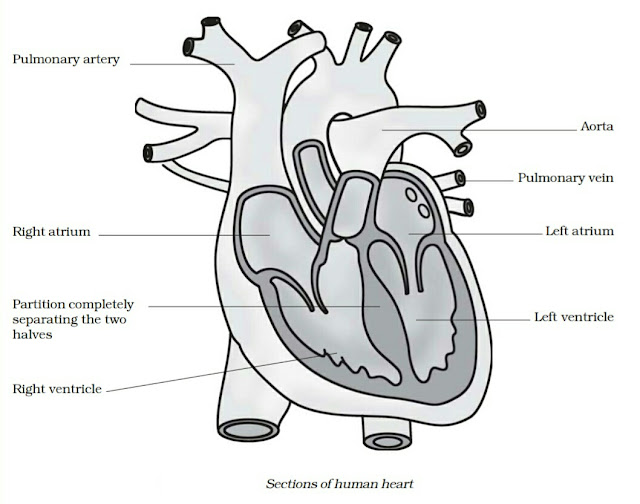Class 7 Science
Chapter- 11
Transportation in Animals and Plants Notes
CIRCULATORY SYSTEM-
Circulatory system consists of the heart and blood vessels.
Blood-
Blood is the fluid which flows in blood vessels. It transports substances like digested food from the small intestine to the other parts of the body. It carries oxygen from the lungs to the cells of the body. It also transports waste for removal from the body.
The fluid part of the blood is called plasma. One type of cells are the red blood cells(RBC) which contain a red pigment called haemoglobin.
The blood also has white blood cells(WBC) which fight against germs that may enter our body.
After cut on the body blood is flow and the clot is formed because of the presence of another type of cells in the blood, called platelets.
Blood vessels-
Two types of blood vessels are present in the arteries and veins of the body.
Two types of blood vessels are present in the arteries and veins of the body.
Arteries- Arteries oxygen-rich blood from the heart to all parts of the body. Since the blood flow is rapid and at a high pressure, the arteries have thick elastic walls.
Veins- Veins the vessels which carry carbon dioxide-rich blood from all parts of the body back to the heart. The vein have thin walls. There are valves present in veins which allow blood to flow only towards the heart.
The arteries divide into smaller vessels. On
reaching the tissues, they divide further
into extremely thin tubes called capillaries. The capillaries join up to form veins which empty into the heart.
Heart-
The heart is an organ which beats continuously to act as a pump for the transport of blood, which carries other substances with it.
The heart is located in the chest cavity with its lower tip slightly tilted towards the left.
the heart has four chambers. The two upper chambers are called the atria (singular:atrium) and the two lower chambers are called the ventricles.
The partition between the chambers helps to avoid mixing up of blood rich in oxygen with the blood rich in carbon dioxide.
Heartbeat-
The walls of the chambers of the heart
are made up of muscles. These muscles
contract and relax rhythmically. This
rhythmic contraction followed by its relaxation constitute a heartbeat.
Heart-
The heart is an organ which beats continuously to act as a pump for the transport of blood, which carries other substances with it.
The heart is located in the chest cavity with its lower tip slightly tilted towards the left.
the heart has four chambers. The two upper chambers are called the atria (singular:atrium) and the two lower chambers are called the ventricles.
The partition between the chambers helps to avoid mixing up of blood rich in oxygen with the blood rich in carbon dioxide.
Heartbeat-
The walls of the chambers of the heart
are made up of muscles. These muscles
contract and relax rhythmically. This
rhythmic contraction followed by its relaxation constitute a heartbeat.
- The human heart beats about 70–80 times per minute in an adult person. This is called heart rate.
EXCRETION IN ANIMALS-
- Removal of waste products from the body is called excretion.
- Excretory system of humans consists of two kidneys, two ureters, a urinary bladder, and urethra.
- Salts and urea are removed along with water as sweat.
- Fish excrete waste substances which directly dissolve in water.
- Birds, insects and lizard excrete uric acid in semi-solid form.
Excretory system in humans-
- The waste which is present in the blood has to be removed from the body.
- When the blood reaches the two kidneys it contains both useful and harmful substances. The useful substances are absorbed back into the blood. The wastes dissolved in water are removed as urine.
- From the kidneys, the urine urine goes into the urinary bladder through tube-like ureters. It is ureters stored in the bladder and is passed out through the urinary opening at the end of a muscular tube called urethra.
TRANSPORT OF SUBSTANCES IN PLANTS-
- Water and mineral nutrients are absorbed by roots from the soil.
- Nutrients are transported along with water to the entire plant via the vascular tissue called xylem.
- The vascular tissue for the transport of food to the various parts of the plant is phloem.
- A lot of water is lost by plants in the form of vapour through stomata during transpiration.
- Transpiration generates a force which pulls up water absorbed by the
- roots from the soil, to reach the stem and leaves.








No comments:
Post a Comment